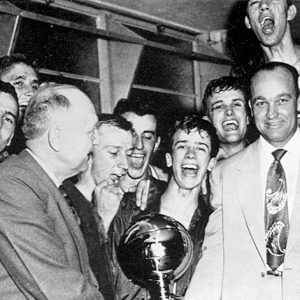calsfoundation@cals.org
Arkansas Intercollegiate Conference
The Arkansas Intercollegiate Conference (AIC) was an athletic confederation of Arkansas colleges and universities that was formed in 1928 as the Arkansas Intercollegiate Athletic Conference. The AIC was affiliated with the National Association of Intercollegiate Athletics (NAIA), which was headquartered at Kansas City, Missouri. Most of the state’s four-year colleges and universities were members of the AIC at one time or another during its existence, with what are now Arkansas State University (ASU) in Jonesboro (Craighead County) and the University of Arkansas at Little Rock (UALR) among the original members. The league disbanded in the spring of 1995.
During most of the 1960s, 1970s, and 1980s, the AIC consisted of five state schools and five private schools. The state schools that were members of the conference were Arkansas Tech University in Russellville (Pope County), the University of Central Arkansas (UCA) in Conway (Faulkner County), the University of Arkansas at Monticello (UAM), Henderson State University (HSU) in Arkadelphia (Clark County), and Southern Arkansas University (SAU) in Magnolia (Columbia County). The private schools that were AIC members were the University of the Ozarks in Clarksville (Johnson County), Harding University in Searcy (White County), Hendrix College in Conway, Ouachita Baptist University (OBU) in Arkadelphia, and Lyon College in Batesville (Independence County). (Most of those schools had name changes during that period.) Lyon, Hendrix, and the University of the Ozarks had dropped football by the mid-1960s but continued to compete in the AIC in other sports. The University of Arkansas at Pine Bluff (UAPB) was a member of the AIC from 1970 to 1972 and 1983 to 1987.
The first champions of the conference in men’s sports were UCA in basketball in 1928, UCA in baseball in 1928, Hendrix in track and field in 1928, SAU in football in 1929, OBU in tennis in 1948, Henderson in golf in 1948, UCA in cross country in 1962, Arkansas Tech in bowling in 1963, and Hendrix in swimming and diving in 1964.
The AIC began sanctioning women’s sports during the 1983–84 school year. The first women’s champions were Lyon in cross country in 1983, Arkansas Tech in volleyball in 1983, UCA in basketball in 1984, Hendrix in swimming and diving in 1984, Harding in softball in 1984, Lyon in track and field in 1984, and UCA in tennis in 1984.
In 1957, the AIC began presenting the Cliff Shaw Scholar-Athlete Award to the senior male athlete who posted the highest academic grade point average and earned at least two athletic letters in AIC-sponsored sports. The first winner of the award was John Clem of OBU. In 1984, the AIC began giving a similar award for women’s athletes known as the Downing-Swift-Wallace Award. The first recipient was Marci Crump of Harding. The AIC began awarding an all-sports trophy in 1964. UCA won the award the first four years it was presented. SAU captured the all-sports trophy in five of the next seven years.
Cliff Shaw of Little Rock (Pulaski County) generally is regarded as the most important figure in conference history. Once a shortstop for the Little Rock Travelers (later the Arkansas Travelers), Shaw began officiating athletic events in 1930, officiating for thirty-five years in the Southwest Conference, the Big Eight, and the Big Ten. Shaw was inducted into the Arkansas Sports Hall of Fame in 1981 and the Arkansas Officials Association Hall of Fame in 1996. Shaw became the AIC commissioner in 1956, replacing General H. L. McAlister of Conway. Although the commissioner’s job was an unpaid, part-time position for Shaw (his main job was with Coleman Dairy of Little Rock), he devoted many hours to the conference. Under Shaw’s direction, the AIC became known for having the finest officiating corps of any small college conference in the country.
Shaw served as commissioner until 1971, when he was replaced by Charles Adcock of Little Rock. Adcock was replaced as commissioner by Leroy Nix Jr., who was, in turn, replaced in 1978 by Sid Simpson. After just one year as commissioner, Simpson was replaced by Harry T. Hall of Dyess (Mississippi County), a retired U.S. Army colonel. Hall was a building supervisor for the Little Rock School District when he was named commissioner, having spent two decades as a college basketball official. Hall served in the role until the conference disbanded.
Dozens of inductees into the Arkansas Sports Hall of Fame attended or coached at AIC schools. The conference’s first recognized All-Americans were Raymond “Rabbit” Burnett of UCA in football in 1937, Ken Stephens of UCA in outdoor track in 1951, E. C. O’Neal of Arkansas Tech in basketball in 1954, Bill Tiner of UCA in baseball in 1960, Cliff Clark of Harding in cross country in 1965, Tom Bateman of Harding in indoor track in 1966, Charles Burt of Harding in bowling in 1967, Jim Saucedo and Mike Pelizza of OBU in tennis in 1967, John Bumpers of Hendrix in swimming in 1971, and Stan Lee of UCA in golf in 1972.
The first three AIC-connected individuals to be inducted into the national NAIA Hall of Fame were former coaches—Ivan Grove of Hendrix for football in 1957, John Tucker of Arkansas Tech for football in 1960, and Sam Hindsman of Arkansas Tech for basketball in 1965. The first two former AIC athletes to go into the NAIA Hall of Fame were Eddie Meador of Arkansas Tech for football and E. C. O’Neal of Arkansas Tech for basketball in 1967.
By the early 1990s, many of the NAIA schools across the country that played football were moving to National Collegiate Athletic Association (NCAA) Division II. UCA, which at the time had a much larger enrollment than the other AIC member schools, decided to make the move to NCAA Division II beginning with the 1993–94 school year. HSU’s board of trustees voted to follow the UCA Bears in the fall of 1993 into NCAA Division II. Both schools joined the Gulf South Conference, which also had member schools in Mississippi, Alabama and Georgia.
The defections of UCA and HSU left the AIC with just five football-playing schools—UAM, SAU, Arkansas Tech, OBU, and Harding. UAM, SAU, and Arkansas Tech were admitted to the Gulf South Conference beginning with the 1995–96 school year, bringing an end to the AIC. The Gulf South refused to admit OBU and Harding, the only two private colleges playing football in Arkansas at the time. OBU and Harding became part of the Lone Star Conference, which also had member schools in Texas, Oklahoma, and New Mexico. OBU and Harding were admitted to the Gulf South Conference beginning with the 2000–01 school year.
UCA, meanwhile, left the Gulf South Conference to move into NCAA Division I, becoming a Southland Conference member in 2006. Beginning with the 2011–12 school year, six former AIC members—Henderson, UAM, SAU, OBU, Harding, and Arkansas Tech—became charter members of the new NCAA Division II Great American Conference. Several former members of the Oklahoma Intercollegiate Conference also are affiliated with the Great American Conference, which is headquartered at Russellville.
For additional information:
“August 26, 2013: Arkansas Intercollegiate Conference.” Arkansas Sports Hall of Fame. http://www.arksportshalloffame.com/?s=aic (accessed October 14, 2021).
“Remembering the AIC.” Rex Nelson’s Southern Fried. http://www.rexnelsonsouthernfried.com/?p=5084 (accessed October 14, 2021).
Rex Nelson
Arkansas’ Independent Colleges & Universities
 Battle of the Ravine
Battle of the Ravine Charity Games of Football (1931)
Charity Games of Football (1931) Rice Bowl
Rice Bowl Sylvester Benson
Sylvester Benson  Tech Men's Basketball
Tech Men's Basketball 




Comments
No comments on this entry yet.